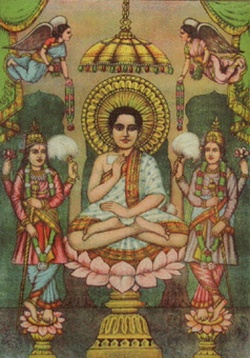Tipitaka
Tipitaka (Tripitaka in Sanskrit) is the name given to the Buddhist sacred scriptures and is made up of two words; ti meaning ‘three’ and pitaka meaning ‘basket.’
The word basket was given to these writings because they were orally transmitted for some centuries (from about 483 BCE), the way a basket of earth at a construction site might be relayed from the head of one worker to another.
It was written on palm leaves in the Pali language around 100 BCE.
The three parts of the Tipitaka are
the Sutta Pitaka,
the Vinaya Pitaka and
the Abhidhamma Pitaka.
The Tipitaka was composed in the Pali language and takes up more than forty volumes in an English translation, roughly about 20,000 pages.
It is the largest sacred book of any of the great world religions.
It is also known as the Pali Canon since the language is in Pali and to better differentiate it from the Mahayana Tripitaka (only one letter difference).
Sutta Pitaka
Digha Nikaya the "long collection"
Majjhima Nikaya the "middle-length collection"
Samyutta Nikaya the "grouped collection"
Anguttara Nikaya the "numerical discourses"
Khuddaka Nikaya the "collection of little texts":
Khuddakapatha
Dhammapada
Udana
Itivuttaka
Sutta Nipata
Vimanavatthu
Petavatthu
Theragatha
Therigatha
Jataka
Niddesa
Patisambhidamagga
Apadana Buddhavamsa
Cariyapitaka Nettippakarana
(Burmese edition) Petakopadesa (Burmese edition) Milindapanha (Burmese edition)
Vinaya Pitaka
I. Suttavibhanga the basic rules of conduct (Patimokkha) for bhikkhus and bhikkhunis, along with the "origin story" for each one.
II. Khandhaka
A. Mahavagga in addition to rules of conduct and etiquette for the Sangha, this section contains several important sutta-like texts, including an account of the period immediately following the Buddha's Awakening,
his first to the group of five monks, and stories of how some of his great disciples joined the Sangha and themselves attained Awakening.
B. Cullavagga an elaboration of the bhikkhus' etiquette and duties, as well as the rules and procedures for addressing offences that may be committed within the Sangha.
III. Parivara
A recapitulation of the previous sections, with summaries of the rules classified and re-classified in various ways for instructional purposes.
Abhidhamma Pitaka
Dhammasangani ("Enumeration of Phenomena").
This book enumerates all the paramattha dhamma (ultimate realities) to be found in the world.
Vibhanga ("The Book of Treatises").
This book continues the analysis of the Dhammasangani, here in the form of a catechism.
Dhatukatha ("Discussion with Reference to the Elements").
A reiteration of the foregoing, in the form of questions and answers.
Puggalapannatti ("Description of Individuals").
Somewhat out of place in the Abhidhamma Pitaka, this book contains descriptions of a number of personality-types.
Kathavatthu ("Points of Controversy").
Another odd inclusion in the Abhidhamma, this book contains questions and answers that were compiled by Moggaliputta Tissa in the 3rd century BCE, in order to help clarify points of controversy that existed between the various early schools of Buddhism at the time.
Yamaka ("The Book of Pairs").
This book is a logical analysis of many concepts presented in the earlier books.
In the words of Mrs. Rhys Davids, an eminent 20th century Pali scholar, the ten chapters of the Yamaka amount to little more than "ten valleys of dry bones."
Patthana ("The Book of Relations").
This book, by far the longest single volume in the Tipitaka (over 6,000 pages long in the Siamese edition), describes the 24 paccayas, or laws of conditionality, through which the dhammas interact.
These laws, when applied in every possible permutation with the dhammas described in the Dhammasangani, give rise to all knowable experience.
The Tipitaka on Dhamma Wiki
See the Pali Canon category link on the Main Page for large parts of the Tipitaka in English translation and also in the original Pali.
See also; Tripitaka


